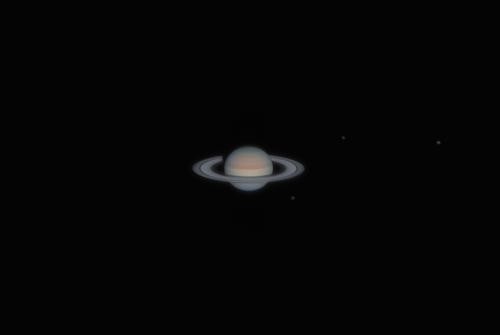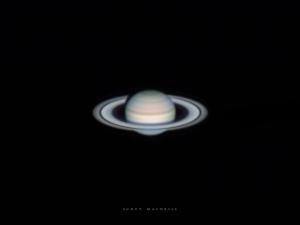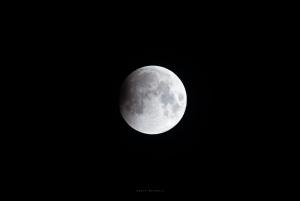Celebration of Space - September 6, 2024

Saturn's rings and moons in 2022. Image Credit: Scott MacNeill captured this image at Brown University's Ladd Observatory.
This coming Sunday, September 8, 2024, Earth will arrive at the point in our orbit where Saturn will be aligned with Earth and the Sun, with Saturn being on the opposite side of Earth than the Sun. We call this the opposition of Saturn, and it places Saturn into best viewing for the 2024 viewing season. On the day of opposition, Saturn will rise with the setting Sun, and set with the rising Sun. Opposition will place Saturn at its closest to Earth at a distance of 804,812,075 miles away. Even though Saturn is in great viewing right now, the rings may not appear as you expect.
Saturn has a 29.45 year orbital period, meaning it takes nearly 30 years for Saturn to make one full orbit around the Sun. Saturn has an axial tilt of 26.7º on its axis, and the rings sit over the equator, allowing for a view of Saturn’s axial tilt when observing the rings. As Saturn progresses in its orbit around the Sun, its axial tilt remains constant in tilt and in orientation. This is the same as Earth, and is what gives us our seasons. With Saturn, Earth will catch up every year in our orbit, during which we will observe Saturn’s tilt at progressively changing viewing angles. The result is that we will see Saturn’s rings progress from maximum 26.7º tilt towards us, to 26.7º tilt away from us over a period of 14.7 years. Summer Solstice on Saturn occurred in 2017, when the rings were tilted 26.7º towards us. The Autumnal Equinox on Saturn will occur in 2025. During that event, Saturn’s rings will not be tilted towards us or away from us, and will make Saturn appear to not have rings for a small period of time. Being only one year from this occurrence, Saturn’s rings will look very thin and not as easily visible as they have been for the past 10+ years. Once Saturn’s Autumnal Equinox passes, we will begin to see the underside of Saturn’s rings. Check out this image of Saturn over the years for a visual of this phenomenon.
Even though opposition only lasts for one day, the views will be spectacular for several weeks around the date of opposition. Now is the time to get out and catch a view of Saturn, and take in the last view of the top side of Saturn’s rings for the next 15 years.
On Saturday, September 14, 2024, the Frosty Drew Observatory and Science Center will host our fourth annual Inspire, Discover, Enlighten, and Awe (IDEA) Expo fundraiser event. A day to learn about the history and future of the Frosty Drew Observatory and Science Center. The event will start at 2:00 pm, and will include light refreshments, tours of our campus and facilities, several presentation stations about the organization and astrophysical science, and opportunities to meet the Astronomy Team and our Board of Directors. This will be a fantastic day to become acquainted with and support the Frosty Drew mission.
Additionally, our annual International Observe the Moon Night event will happen consecutively with the IDEA Expo. Starting at 6:30 pm, the Frosty Drew campus will switch over to all things lunar. We will have telescopes directed at the Moon, showing the lunar surface at different magnifications. Screens around the campus will show video features about the Moon. The Lunar Lounge will show a live projection of the Moon from a telescope. The Sky Theatre will host NASA Solar System Ambassador, Frank Puglia, who will be presenting about the Moon. It’s an evening to celebrate Earth’s only natural satellite alongside thousands of other science and educational institutions around the world. So make your plans to visit Frosty Drew on Saturday the 14th for a day of astronomical amazement.
Take a moment to read about the events at:
IDEA-Expo
International Observe the Moon Night
Save the Date: Harvest Moon Eclipse
On Tuesday, September 17, 2024, the annual Harvest Moon will occur, and a partial lunar eclipse will accompany the festive Moon. Starting at 9:00 pm, the Frosty Drew campus will open in eclipse mode with telescopes set up on the Moon. The eclipse itself will become quite visible around 10:00 pm. Maximum eclipse happens at 10:44 pm, during which 9.1% of the Moon will be in the umbra – Earth’s primary shadow. The eclipse ends at 12:47 am, with partial eclipse ending at 11:15 pm. This will be a fantastic send off of summer with a night under the eclipsed Harvest Moon. As the date approaches we will write more about the night. For now, check out our event page.
This coming week the International Space Station (ISS) will return to evening sky, offering fantastic visible passes that are easy to get out and see. Due to the inclination of the ISS orbit, we see the station pass over in cycles. Sometimes passes are visible in the evening, other times in the early morning hours, and sometimes not at all. The current cycle of evening passes will continue until October 3, 2024, which gives sky watchers many chances to step out and catch a view. Here are a few notable passes of the ISS for the coming week:
Tue, Sep 10 at 8:57 pm, starting in the SW, rising to 54º, and into orbital sunset
Wed, Sep 11 at 8:14 pm, starting in the SW, rising to 59º, heading towards the ENE, and into orbital sunset
Thu, Sep 12 at 7:32 pm, starting in the SSW, rising to 38º, heading towards the ENE
Thu, Sep 12 at 9:09 pm, starting in the W, rising to 33º, and into orbital sunset
Put these pass times on your calendar and set your alarms. Seeing the ISS pass over is quite an inspiring experience, and well worth a few minutes to step outside to catch the view.
- Author:
- Scott MacNeill
- Entry Date:
- Sep 6, 2024
- Published Under:
- Scott MacNeill's Columns




